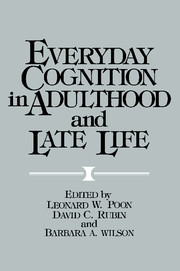Book contents
- Frontmatter
- Contents
- List of contributors
- Preface
- Part I Adult cognitive abilities in the laboratory and in real-life settings: Basic theoretical and methodological issues
- Part IA Systematic approaches to laboratory and real-world research
- Part IB Combining laboratory and real-world research
- Part II Cognition in adulthood and late life: Findings in real-life settings
- Part IIA Everyday cognitive abilities
- 11 Memory for prose: Perspectives on the reader
- 12 Prose processing in adulthood: The text, the reader, and the task
- 13 Speech comprehension and memory through adulthood: The roles of time and strategy
- 14 The effects of aging on perceived and generated memories
- 15 Aging and word retrieval: Naturalistic, clinical, and laboratory data
- 16 Acquisition and utilization of spatial information by elderly adults: Implications for day-to-day situations
- 17 Inner-city decay? Age changes in structure and process in recall of familiar topographical information
- 18 The cognitive ecology of problem solving
- 19 Everyday problem solving: Methodological issues, research findings, and a model
- 20 Prospective/intentional memory and aging: Memory as adaptive action
- Part IIB Concomitant influences
- Part III Cognitive enhancement and aging: Clinical and educational applications
- Part IIIA Issues and perspectives
- Part IIIB Enhancement approaches
- Part IIIC Designing programs for cognitive rehabilitation
- Subject index
- Author index
11 - Memory for prose: Perspectives on the reader
Published online by Cambridge University Press: 05 October 2013
- Frontmatter
- Contents
- List of contributors
- Preface
- Part I Adult cognitive abilities in the laboratory and in real-life settings: Basic theoretical and methodological issues
- Part IA Systematic approaches to laboratory and real-world research
- Part IB Combining laboratory and real-world research
- Part II Cognition in adulthood and late life: Findings in real-life settings
- Part IIA Everyday cognitive abilities
- 11 Memory for prose: Perspectives on the reader
- 12 Prose processing in adulthood: The text, the reader, and the task
- 13 Speech comprehension and memory through adulthood: The roles of time and strategy
- 14 The effects of aging on perceived and generated memories
- 15 Aging and word retrieval: Naturalistic, clinical, and laboratory data
- 16 Acquisition and utilization of spatial information by elderly adults: Implications for day-to-day situations
- 17 Inner-city decay? Age changes in structure and process in recall of familiar topographical information
- 18 The cognitive ecology of problem solving
- 19 Everyday problem solving: Methodological issues, research findings, and a model
- 20 Prospective/intentional memory and aging: Memory as adaptive action
- Part IIB Concomitant influences
- Part III Cognitive enhancement and aging: Clinical and educational applications
- Part IIIA Issues and perspectives
- Part IIIB Enhancement approaches
- Part IIIC Designing programs for cognitive rehabilitation
- Subject index
- Author index
Summary
Memory serves many functions in the everyday transactions between the individual and the world. For example, we remember to stop at the grocery store, we remember where the grocery store is located, we remember how to drive an automobile in order to get to the grocery store, and, once there, we remember that we need to acquire the makings of a company meal scheduled for 2 days hence. These pieces of remembered information could be acquired in a number of ways, but in many everyday examples the remembered information is acquired through the processing of spoken or written language. We might, for example, hear or read instructions on how to drive a stick-shift automobile. The sequence of operations described in the verbal instructions would be stored and translated into a sequence of motor actions. Of course, the activity would not progress smoothly until such time as the motor actions became relatively automatic, but the initial representation of the activity could be acquired through spoken or written language. This chapter is concerned with the acquisition of information from written language (referred to as “prose” or “discourse”). The acquisition of information from spoken language is taken up in Chapter 13 by Stine, Wingfield, and Poon.
This chapter begins with a brief natural history of research in the area in which various kinds of studies intersect: discourse-processing, memory, and aging studies. Next, the current status in this research area is described, and the interpretation of current findings within existing models is outlined.
- Type
- Chapter
- Information
- Everyday Cognition in Adulthood and Late Life , pp. 135 - 156Publisher: Cambridge University PressPrint publication year: 1989
- 17
- Cited by



